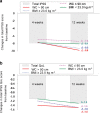Comparison of the clinical efficacy of medical treatment of symptomatic benign prostatic hyperplasia between normal and obese patients
- PMID: 21499281
- PMCID: PMC3739575
- DOI: 10.1038/aja.2011.5
Comparison of the clinical efficacy of medical treatment of symptomatic benign prostatic hyperplasia between normal and obese patients
Abstract
We aimed to investigate the difference in efficacy of medical treatment of symptomatic benign prostatic hyperplasia (BPH) between normal and obese patients with BPH; obesity was determined by either body mass index (BMI) or waist circumference (WC). In this 12-week prospective observational study, a total of 175 patients aged ≥40 years with International Prostate Symptom Scores (IPSS) ≥12 points and prostate volume ≥20 ml were prospectively enrolled. The patients were divided into two groups according to BMI or WC. Patients received the doxazosin gastrointestinal therapeutic system (GITS) at a dose of 4 mg once per day for 12 weeks. The changes from baseline in the IPSS, maximal urinary flow rate (Q(max)), post-void residual volume, quality of life (QoL) scores and adverse events (AEs) were analysed. Of the 175 enrolled patients, 132 completed the study. Sixty-seven patients had BMI >23 kg m⁻², and 43 had WC >90 cm. Obese patients represented by WC >90 cm or BMI ≥23 kg m⁻² had a significantly greater prostate volume compared with non-obese patients at baseline. Total IPSS was significantly higher in the WC >90 cm group compared to the WC ≤90 cm group. Total IPSS was positively correlated with prostate volume (P=0.031) and WC (P=0.045). All groups showed significant improvements in total IPSS and QoL at 12 weeks. However, the improvement of total IPSS was greater in the high-BMI and high-WC groups. The most frequent AE was dizziness (n=13), and it was significantly lower in the obese BPH patients. Obesity was associated with increased prostate volume and lower urinary tract symptoms. Alpha-blockers appear to be efficacious for controlling symptoms, especially in obese men.
Figures


Comment in
-
Re: Comparison of the clinical efficacy of medical treatment of symptomatic benign prostatic hyperplasia between normal and obese patients.J Urol. 2012 Oct;188(4):1235. doi: 10.1016/j.juro.2012.06.079. Epub 2012 Aug 17. J Urol. 2012. PMID: 22971392 No abstract available.
References
-
- Saigal CS, Joyce G. Economic costs of benign prostatic hyperplasia in the private sector. J Urol. 2005;173:1309–13. - PubMed
-
- Parsons JK, Sarma AV, McVary K, Wei JT. Obesity and benign prostatic hyperplasia: clinical connections, emerging etiological paradigms and future directions. J Urol. 2009;182:S27–31. - PubMed
-
- Kim DM, Ahn CW, Nam SY. Prevalence of obesity in Korea. Obes Rev. 2005;6:117–21. - PubMed
-
- Park YH, Chung MK. The prevalence of clinical benign prostatic hyperplasia and lower urinary tract symptoms in South-East Korea: a community-based study. J Pusan Natl Univ Hosp. 2001;9:141–57.
-
- Lee MW, Lee KS. The prevalence of benign prostatic hyperplasia in self-referral populations over aged 50. Korean J Urol. 1996;37:263–7.
Publication types
MeSH terms
Substances
LinkOut - more resources
Full Text Sources
Medical

